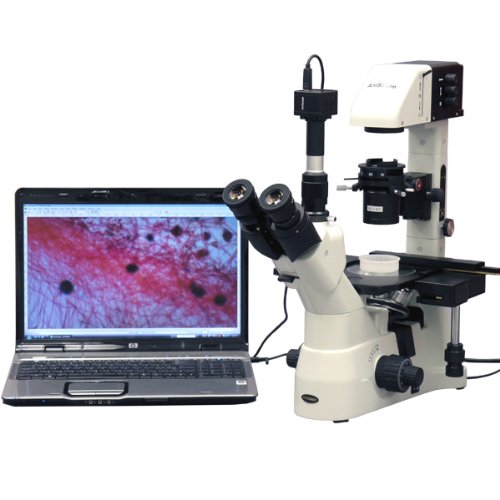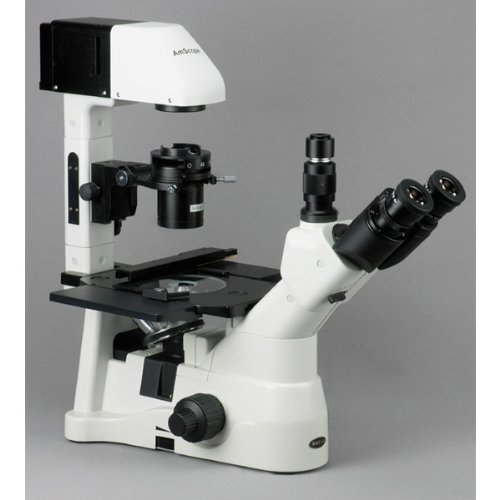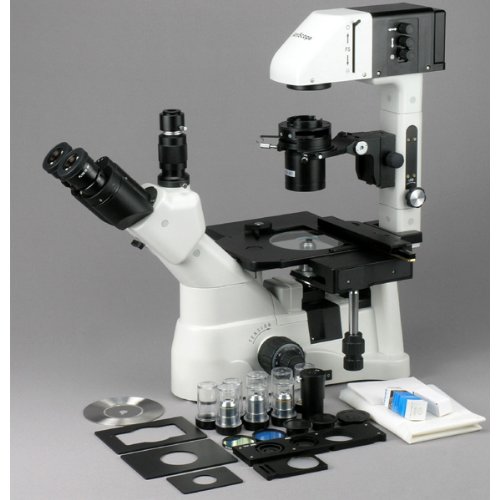Description
The AmScope IN480TC-8M digital inverted trinocular compound microscope has interchangeable pairs of 10x22mm and WH25x10mm plan high-eyepoint super-widefield eyepieces, an under-mounted quintuple nosepiece, eight DIN long working-distance infinity plan objectives, top-mounted Brightfield 30W halogen illumination, a 0.3 NA Kohler condenser with iris diaphragm, and a double-layer mechanical stage with a stage stop to give protection to slides and objectives from damage. The 8MP camera has a CMOS color sensor, a reduction lens, image capture and editing software, and USB 2.0 output to capture or display still or video images on a pc or projector. The microscope has a color-corrected infinity optical system (CCIS) that provides color correction and improved focal point of the intermediate image across all the focal plane. The trinocular head has a Siedentopf binocular mount with 50 to 76mm interpupillary adjustment and a fixed 45-degree vertical inclination to reduce eye and neck strain. A Siedentopf binocular head enables the viewer to change the interpupillary distance without changing the tube length, getting rid of the wish to refocus the image. Anti-mold coatings offer protection to the microscope in high-humidity environments. The microscope includes interchangeable pairs of high-eyepoint super-widefield WH10x22mm and WH25x10mm plan eyepieces. Plan eyepieces provide improved focal point over all the field of view (FOV). High-eyepoint eyepieces ease viewing for viewers who wear glasses. Dioptric adjustment comprises individual eye-strength differences. The vertical trinocular port accepts a 23mm or C-Mount camera. The under-mounted quintuple nosepiece accepts as much as five 20mm objectives at a time. The microscope includes five Brightfield long working-distance infinity plan objectives (4x, 10x, 20x, 40x, and 60x) and three phase-contrast long working-distance infinity plan objectives (10x, 20x, and 40x). Long working-distance plan objectives provide improved focal point over all the range of the viewing field and a longer working distance that may be required when viewing specimens in dishes and large containers. Phase-contrast provides high contrast and visibility without using stains, allowing specimens to be observed in their natural state without being killed or fixed. An inverted microscope has its light source above the stage pointing downward and the objectives and turret below the stage pointing upward. It’s most frequently used for observing organisms in a big container, such as a well plate or petri dish. It will also be used when specimens require manipulation, or in metallurgical applications.
The 8MP digital camera has a CMOS color sensor for displaying still microscopy images and streaming live videos to a pc or projector. The camera has 40x magnification and a 0.5x reduction lens that ensures that the display has a similar field of view as the microscope eyepiece. The camera may also be mounted in a C-Mount or any 23mm eye tube. The camera includes image capture and editing software that provides still image and live video capture and editing capability, including measurement functions. The software supports JPG, TIF, GIF, PSD, WMF, and BMP file formats and is compatible with Windows XP, Vista, 7, and 8; Mac OS X; and Linux. Camera drivers are compatible with Windows XP, Vista, 7, and 8; Mac OS X; and Linux. The software includes Windows APIs for native C/C++, C#, DirectShow, Twain, and LabVIEW that enable custom application development. The camera has a USB 2.0 data port (cable included).
Brightfield and phase-contrast illumination is mounted above the stage and has transmitted 30W halogen illumination. Brightfield (BF) illumination allows the specimen to take in light, resulting in a dark image on a light background. . The phase-contrast element aligns the light source with the phase-contrast objectives to optimize high contrast and visibility without using stains. Halogen illumination provides bright light in a concentrated path, and a rheostat controls the amount of light emanating from the lamp. The objectives are mounted on a turret to ease magnification changes. The Kohler condenser has a 0.3 NA to provide a long working-distance of 72mm and 28mm, respectively. Kohler illumination focuses and centers the light path the use of two iris diaphragms, providing optimum contrast and resolution. The horizon may also be rotated 0 to 300 degrees. The double-layer mechanical stage with 1mm stage divisions and 0.1mm vernier resolution locks the slide into place and provides precise slide manipulation along the X- and Y-axis to allow coordinates to be recorded, enabling the viewer to go back to a specific location at the slide. The oversize stage is 6.3 x 10 inches (160 x 250mm) (W x D, where W is width, the horizontal distance from left to right; D is depth, the horizontal distance from front to back). It has a traveling range of 4-3/4 x 3-1/8 inches (X- direction x Y-direction). A petri dish holder secures specimens in place. Nested coaxial coarse and fine focal point has tension-adjustable coarse focusing and an adjustable lock ring stopper that limits stage range to give protection to slides and objectives from damage. The point of interest system has a 38mm working distance, 2mm fine focal point, and 0.002mm precision. The total working distance is 6.5mm upward and 2.5mm downward from focal point. All-metal mechanical parts, solid-metal frame construction, and a stain-resistant enamel finish provide durability.
| Microscope Specifications | |
|---|---|
| Head | Siedentopf trinocular |
| Magnification range | 40x-1500x |
| Trinocular port | 23mm or C-Mount |
| Eyepieces (30mm) | WH10x22mm plan and WH25x10mm plan |
| Objectives, Brightfield (20mm) | 4x, 10x, 20x, 40x, and 60x DIN long working-distance infinity plan objectives |
| Objectives, Phase-contrast (20mm) | 10x, 20x, 40x DIN long working-distance infinity plan objectives |
| Stage | Oversize mechanical, with removable stage plate |
| Condenser | Movable 0.3 NA Kohler condenser |
| Light source | Halogen with rheostat, 12V/30W |
| Illumination type | Brightfield, phase-contrast |
| Power | 90V to 240V, GS and CE-certified |
| Camera Specifications | |
|---|---|
| Resolution | 8MP (3264 x 2448 effective pixels) |
| Image type | Still image and video display and capture |
| Camera type | Brightfield |
| Camera sensor | 1/2.5″ Aptina Special CMOS (color) |
| Magnification | 40x |
| Reduction lens | 0.5x |
| Mounting size | 23mm or C-Mount |
| Frame rate | 27fps at 800×600; 8fps at 1600×1200; 1.9fps at 3264×2448 |
| Computer connection | USB 2.0 (backward compatible on PCs only) |
| File formats | JPG, TIF, GIF, PSD, WMF, BMP |
| Software package | Image capture and editing for Windows XP, Vista, 7, and 8; Mac OS X; and Linux |
| Camera driver compatibility | Windows XP, Vista, 7, and 8; Mac OS X; and Linux |
Microscopes are instruments used to give a boost to the resolution of an object or image. Types include compound, stereo, or digital. Compound microscopes use a compound optical system with an objective lens and an eyepiece. Stereo microscopes show object depth in a three-dimensional image. Digital microscopes are used to display an image on a monitor, reasonably than taking a look through a lens. Microscopes can have monocular (one), binocular (two), or trinocular (three) eyepieces, with varying magnification abilities. Magnification ability refers back to the size of an image. Resolution, sometimes called resolvant power, refers back to the clarity of the image. The interaction between field of view (FOV), numerical aperture (NA), and working distance (WD) determines resolution. Microscopes can regulate magnification through a fixed focal point, or through a range of adjustments. They may be able to also utilize LED, fluorescent, and mirror light sources to lend a hand regulate viewing capabilities. Microscopes are widely used in education, lab research, biology, metallurgy, engineering, chemistry, manufacturing, and in the medical, forensic science, and veterinary industries.
United Scope manufactures microscopy equipment and accessories under the brand name AmScope. The company, founded in 1996, is headquartered in Irvine, CA.
What’s in the Box?
- AmScope IN480TC-8M microscope
- WH10x22mm plan eyepieces, 30mm, one pair
- WH25x10mm plan eyepieces, 30mm, one pair
- 4x DIN long working-distance infinity plan objective, 20mm
- 10x DIN long working-distance infinity plan objective, 20mm
- 20x DIN long working-distance infinity plan objective, 20mm
- 40x DIN long working-distance infinity plan objective, 20mm
- 60x DIN long working-distance infinity plan objective, 20mm
- 10xPH DIN long working-distance infinity plan phase-contrast objective, 20mm
- 20xPH DIN long working-distance infinity plan phase-contrast objective, 20mm
- 40xPH DIN long working-distance infinity plan phase-contrast objective, 20mm
- Color filters
- 8MP digital camera (MU800)
- 0.5x reduction lens
- USB 2.0 cable
- Software CD
- Reflected illuminations system with top light housing and electrical cord
- Episcopic light box and tube
- Power cord
- Dust cover
- Instructions
Digital inverted compound microscope for statement of biological cultures or specimens within well plates, petri dishes, or vials that require a longer working distance, and an 8MP camera with reduction lens and USB 2.0 output for capturing or displaying images on a pc or projector
Trinocular head with Siedentopf binocular mount, pairs of 10x22mm and WH25x10mm plan high-eyepoint super-widefield eyepieces, 50 to 76mm interpupillary adjustment, and fixed 45-degree vertical inclination; vertical port accepts C-Mount or 23mm camera
Color-corrected infinity optical system (CCIS) with under-mounted quadruple nosepiece, five long working-distance infinity plan objectives and three long working-distance phase-contrast infinity plan objectives that provide a longer working distance and improved focal point over all the viewing field
Upper-mounted rheostat-controlled 30W halogen illumination provides clear examination and light regulate and movable 0.3 NA Kohler condenser provides long working distance
Oversize mechanical stage with petri dish holder and tension-adjustable coaxial coarse and fine focal point






Reviews
There are no reviews yet.